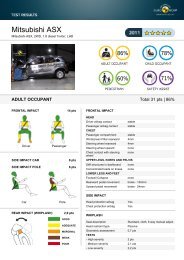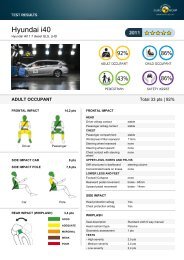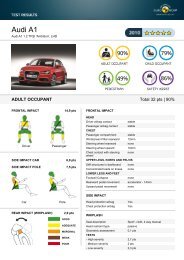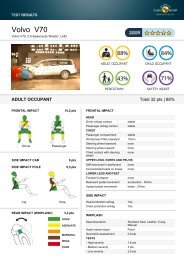Whiplash Testing Protocol - Euro NCAP
Whiplash Testing Protocol - Euro NCAP
Whiplash Testing Protocol - Euro NCAP
You also want an ePaper? Increase the reach of your titles
YUMPU automatically turns print PDFs into web optimized ePapers that Google loves.
11.3 Upper Neck Shear Force (Fx) and Upper Neck Tension (Fz)<br />
The upper neck loadcell of the BioRID records both shear and tensile forces. If the instrumentation is<br />
configured in accordance with SAE J211, positive shear should be indicative of a head-rearwards<br />
motion and positive tension should be associated with pulling the head upwards, generating a tensile<br />
force in the neck. Firstly, both the Fx and Fz channels should be filtered at CFC 1000.<br />
Peak values, Fx max and Fz max, should then be determined for each of the forces, considering only the<br />
portion of data from T-zero until T-HRC(end), as follows:<br />
11.4 Head Rebound Velocity – Acceleration Sled Technique<br />
The head rebound velocity (in the horizontal/X direction) should be determined using target tracking.<br />
Ideally this should be performed using footage acquired from on-board camera systems, however<br />
off-board systems can provide suitable views providing the camera positioning is correct and<br />
compensation is made for the movement of the sled. Various proprietary film analysis packages<br />
include functions to achieve this analysis consequently this method will not be covered in detail in<br />
this document. Refer to Section 10 for additional considerations regarding the use of high speed<br />
cameras.<br />
11.4.1 Time for occurrence of peak rebound velocity<br />
Theoretically, the peak rebound velocity should occur due to the elastic energy release from the seat<br />
assembly, after the peak sled acceleration has occurred. In the case of an acceleration sled this should<br />
also be prior to the sled braking, which at the earliest should occur from 300ms. It should be verified<br />
that there is sufficient time before the onset of sled braking for the particular sled being used, and that<br />
any peak rebound velocity analysis is not undertaken during the sled braking phase. The rebound<br />
velocity of the ATD is usually generated due to the release of stored elastic energy within the seat<br />
structure, suspension and foam. The time of occurrence of peak rebound velocity should be the<br />
maximum horizontal component of head rebound velocity calculated between T=0 and 300ms.<br />
11.4.2 Target Placement<br />
The ATD should be equipped with a suitable target placed on the side of the head flesh, coincident<br />
with the head centre of gravity (DT6 see Figure 15). Additionally, three sled targets will be required.<br />
Two fixed targets of known separation should be placed on the sled in the same XZ plane, such that a<br />
fixed reference can be obtained that will not be obscured during the test (B1 and B2 targets, see<br />
Figure 15). In the case of an on board view, a small compensation may be required for camera<br />
movement or shake. This can be made using the two fixed targets of known spacing on the sled, and<br />
a third target from which a sled coordinate system may be created.<br />
All target points used for analysis should be depth scaled to compensate for any differences in the<br />
Y-coordinates.<br />
11.4.3 Determination of Rebound Velocity<br />
Using a suitable “target tracking” film analysis technique, generate traces as follows:<br />
Head centre of Gravity target velocity (absolute laboratory reference)<br />
Sled velocity (absolute laboratory reference)<br />
Version 3.1<br />
June 2011<br />
36
















